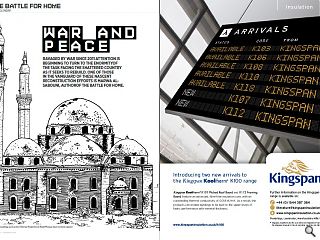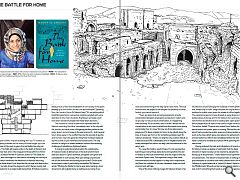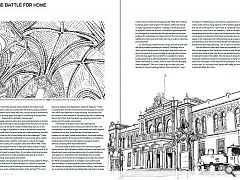The Battle for Home: War and Peace
20 Oct 2017
Ravaged by war since 2011 attention is beginning to turn to Syria and the enormity of the task facing the shattered country as it seeks to rebuild. One of those in the vanguard of these nascent reconstruction efforts is Marwa Alsabouni, author of The Battle for Home.
The book doesn’t just describe the carnage and destruction of war but also shows the degree to which Syrian society had collapsed prior to a single bullet being fired. Al-Sabouni paints a bleak picture of the near breakdown of civil society in the years leading up to the conflict so was civil war inevitable? Speaking from her home in Homs Al-Sabouni said: “It’s something which could be expected in a sense but could be avoided with some alteration to the chain of events. Anything in principle could have been avoided if people had made wiser decisions.” The situation in Homs is now much improved with AlSabouni reporting that life is ‘completely calm’ in the city with the sounds and destruction of lingering battles pushed to the outer desert and arid areas to the east and north - both several hours drive away. In the conflict free city the sounds of gunfire and mortars may have gone but they have not been replaced by the sounds of jack hammers and construction. The city remains in twilight as dazed residents confront the daunting challenge of rebuilding a shattered nation. In trying to understand what led to this catastrophe, Al-Sabouni looks at deficiencies in the built environment itself as a factor in Syria’s downfall, alongside corruption and a breakdown in civil society.
Was Syria always at particular risk of civil strife even discounting social issues? Did the built environment make it particularly susceptible? Al-Sabouni wrote: “Writing the Battle for Home was about writing a local story but to tell a global story as well because many of our cities are transforming in the way Syrian cities have. The built environment has played a role despite the presence of other factors, you cannot ignore it. “There are plans that are being prepared in private conversation between developers and decision makers and as you say it’s not just local conversation, it’s happening internationally. As an architect and a citizen I would like this conversation to be more localized and discussed more openly and socially than it is now.” So how are those discussions playing out? Is there a desire for Homs to be rebuilt along the lines of its pre-war form or for something entirely new?
Al Sabouni answered: “There’s no way the city could be rebuilt as it was because 60% is destroyed, tens of neighborhoods are totally destroyed so there is no way it will look identical to the way it was. “In a way this holds a seed of hope. It’s not necessarily a bad thing as many things were done wrong before the war in relation to the built environment and the shape of the city and other Syrian cities. The important thing is that those transformations should happen in a way that is responsible and fixes the mistakes of the past, whatever shape our built environment will take. One of the more striking images Al-Sabouni draws is her recollections of picnicking by the roadside in Homs prior to war, forced onto a traffic verge because the city lacked any parkland or public open space for people to come together. The experience seems to have shaped an early desire to build better places and a key aim for Al-Sabouni isn’t just to build new homes and facilities but to create public open spaces in which people from all sides of the conflict might come together. The author stated: “Anyone who visited Homs before the war would notice that public space is missing. We had the old souk which had a productive public space and natural public space such as the river, which were once places for gathering for work and recreation but which was vandalized before the war.
We have a chance to recreate such places while planning for the new future.” Having endured the trials and tribulations of recent years Al-Sabouni retains a degree of optimistic that the deep divisions in Syrian society can be overcome, despite the flaring up of sectarianism: “I have reasons to be optimistic and pessimistic. The reason to be pessimistic is looking at past examples of countries that have suffered from civil war. Lebanon is a good example or Ireland (it doesn’t have to be the Middle East). Wounds remain largely open in places of civil war and it’s something that needs a very delicate approach to see how these wounds can be healed. The reason to be optimistic is that in a country with the history of Syria, where it has suffered from many wars and a long history of devastation; this act of rising again and again is something to be optimistic about - despite all the setbacks that we have.”
Clearly optimism alone isn’t going get Syria back on its feet, the scale of the task in hand is beyond the resources of any one country to fix, let alone a nation shattered by war, but is the world at large in a position to come to its aid with some form of Marshall Plan? Is a world beset by its own problems from the Middle East to the US and Britain up to the challenge? “These questions need to be addressed for any country which suffers mass destruction, whether manmade or natural. It’s bigger than one country, the European cities after World War 2 hold so many valuable lessons to take and they’ve made so many mistakes unfortunately, they are demonstrated in front of us so we don’t need to repeat them. It is a matter of will and requires collaboration but it could go disastrously wrong or result in something very positive and fruitful.” Despite voicing regrets about never having visited St Mary’s Church, Khalid Ibn Al-Walid Mosque, Al-Sabouni is adamant that there should be no attempt to build historically accurate replicas or even a digital recreation of the old city? “I’m not in favour of replicas and digitization”, states Al-Sabouni. “I think it compromises the life of those structures because it’s not the end result that mattered in those buildings, the process and the context is what mattered.
By replicating them or reprinting them I don’t think that they keep any integrity and miss the whole point of ancient monuments. “The brilliance of Syrian cites is this layering that occurred, no single period in history cancelled the other. The incorporation of different styles that created this multi-layered civilisation is the very thing that we should keep, not the isolation of one layer. People should be our focus and building around the wisdom of the past and the brilliance of traditional material and construction techniques and space creation - without canceling what was there before.” Of course many of these issues hold relevance beyond Syria’s borders, after all before a bullet had been fired there had already been quite extensive destruction of ancient buildings and spaces for unattractive concrete blocks and car parks. Such issues are common from Glasgow to Houston but where the West has largely learnt its mistakes much of the world seems hellbent on repeating them, particularly in the Middle East where, for example, the authorities in Mecca, Saudi Arabia are in process of demolishing irreplaceable holy places to allow construction of hotels and shopping malls.
Why aren’t historic buildings given more respect? Al-Sabouni offers two words in reply: “Ignorance and greed.” Adding: “It is the ignorance of whoever makes the decision if we assume good intentions but the greed of those who will fill their pockets for any new building. It’s individuals who take control of the community by selfishness, claiming it to be their own toy in order to maximise personal profit.” It’s one thing to rebuild homes, shops and offices but how will Syria go about rebuilding its identity? Buildings offer a direct link to the past and in many ways, they define who we are in the present. Is it even possible to recreate that richness when starting again from scratch? Is it possible to create a building style that is distinctively Syrian in a globalized world where new builds in London, Paris or New York are all largely interchangeable? “We don’t have to go far back just a few decades to look at buildings before mass production”, says Al-Sabouni. “Depending on local factors, experiences and crafts could solve so many aspects of this faceless globalism that we are suffering from. I don’t have a crystal ball. I hope for the best but I don’t like to be unrealistic. I look at the options being presented and the choices on the ground and I don’t see many seeds for hope but I think there are people who are more aware of the importance of craftsmanship, local production and aesthetics and more and more people are talking about architecture and urban planning. This is reason to be hopeful.”
That the flame of hope hasn’t been extinguished in the fires of war suggests that Syria has a future to look forward to and the first seeds of that new future are already beginning to take germinate in the rubble. The old ways of doing things may have fostered a climate of corruption but as Syria steps back from the abyss it finds itself with the prospect of making a fresh start. If it succeeds then Syrians will finally win their own individual battles for home.
|
|
Read next: Exploring Glasgow: City Mission
Read previous: St Cecilia's Hall: Noteworthy
Back to October 2017
Browse Features Archive
Search
News
For more news from the industry visit our News section.
Features & Reports
For more information from the industry visit our Features & Reports section.





